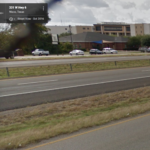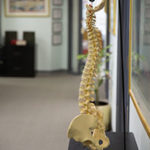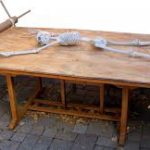I thought I had sciatica. A sharp pain ran across my left hip, down the back of my thigh, and on through my calf. I tried thinking that it would disappear on it’s own. It didn’t. Walking didn’t help. My regular routine at Curves didn’t do anything to alleviate the irritation. It wouldn’t go away.
The pain wasn’t severe. At night, in bed, I could always arrange my leg so that the discomfort diminished; I could sleep. I could do what I needed to do. I just was uncomfortable all the time.

The physical therapy place is right by Providence Hospital. Apparently, there is no nice photo anywhere online.
At my regular checkup, my doctor showed me an exercise that might help and, more importantly, she said she would send me to physical therapy a couple of times. A few days later, therapy phoned and set up an appointment. Therapist Richard did a thorough exam, identified the problem (probably a bulging disc), and explained everything. He gave me a brochure with guidelines for a healthy back, and sent me to the secretary who set up eighteen appointments–three a week for the next six weeks.
The next visit, Richard led me through a few exercises and reviewed the changes I was making at home: how I got in and out of the car, how to lift things properly, and how I should squat instead of bending over to retrieve things I dropped on the floor. I never realized how often I do drop stuff on the floor until I had to squat to pick them up.
In the therapy suite, there are numerous models of various bones and sets of bones. Richard brought over a spine for me to examine.
“If we can stretch out the vertebrae,” he explained, tugging on the lower part of the spine.
“It will give that bulging disc an opportunity to slip back into its place. That will relieve the pressure on it, and make the pain go away.”
He furrowed his brows a little and, with a bit of a question in his voice, suggested we try “mechanical lumbar traction.”
“Fine,” I said. “I want to get better.” He led me to a small room off the physical therapy gym, and we stood together in front of a exam table.
“This belt,” he said, pointing to a wide vinyl strap, “will go around your abdomen. It attaches to the top of the table. This one,” he said, showing me another strap, “will go around your hips. It attaches to this machine.” He pointed to a blinking box at the other end of the table. I looked at him soberly.
“Richard,” I said, solemnly. “This is a rack.”
“Well,” he admitted, “sort of.” And he strapped me in.
- A Rack
Richard explained that the machine would tug for 40 seconds, then relax for 40 seconds. It would repeat that cycle for 20 minutes. He handed me a call button. “You can press this at any time, and it will stop the machine,” he said. “In case it gets unbearable.”
“Is it going to be unbearable?!?” I asked, a little alarmed.
“Well,” he said, “some people feel a little claustrophobic. Sometimes.”
“Ah.”
With that, he walked to the door, switched off the light, and pulled the door closed.
The machine gently tugged for 40 seconds, then rested for 40 seconds. Tugged for 40; rested for 40. I snoozed.
Twenty minutes pass pretty quickly when you’re napping.
Next session, I was ready. I had ear buds and an audio book to listen to while I was mechanically lumbar-tractioned. I loved it. How many times does someone say, “Lie down. Relax. Stay right here for twenty minutes.”
It was certainly my most favorite part of therapy. Besides the rack, I spent time on the squat machine, strengthening my thigh muscles. Numerous exercises, machines, and routines were designed to strengthen my “core,” so my abs would hold me up straight and keep my back strong.
Sometimes, Richard would have me lie down on a large platform, on a pad, and say, “Just for fun . . . .” and then explain some wildly difficult and goofy exercise.
“Richard,” I would reply, “your ideas of fun and my ideas of fun are are as far apart as the East is from the West.”
One such exercise involved my lying, face up, on a long dense foam cylinder, about 6 inches in diameter, that ran from my neck to my hips. With my arms above my head and my feet on the mat, knees up, just balancing on the thing required all my concentration. Then he said, “Just for fun,” (not from where I’m lying, Richard!) “raise your right knee and bring you left hand down to touch it. Then, do that with your left knee and right arm.” As I worked with intense diligence to perform this maneuver, my arms and legs flailed about, and I often rolled right off that thing. I’ve looked online, through several sites that show how to use a foam roller for strengthening and for physical therapy. Out of all of them, only one suggested lying on the thing with it along one’s spine. And they were NOT lifting their legs from the mat.
“Do you ever film patients in therapy,” I asked.
“Sometimes,” Richard said.
“And then do you guys get together at parties and show them to each other and laugh at us.”
“Of course not,” he said, bristling. Hmmm. Maybe I believe him.
Anyway, I needed ten weeks of therapy in all. But I got stronger and the pain disappeared. I do my exercises regularly, and I try to remember to put bags and boxes and my purse on a chair or a counter or a shelf. Then I don’t have to squat down to pick them up again. I’m working on not dropping so much stuff on the floor. And I got a treadmill for walking, which is the best thing for spine health.
For you created my inmost being;
you knit me together in my mother’s womb.
I praise you because I am fearfully and wonderfully made;
your works are wonderful,
I know that full well.
Psalm 139:13-14 (New International Version )



I’m still waiting for my sciatica to go away! Maybe I need to add some extra exercises.
You know you’re getting old when you stoop to tie your shoes and wonder what else you can do while you’re down there. – George Burns
one of my favorite quotes!